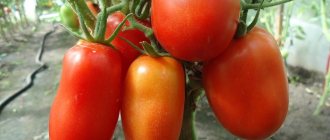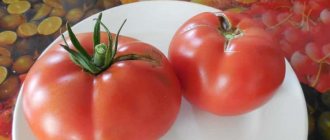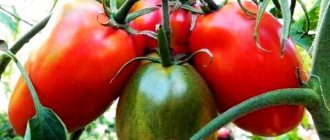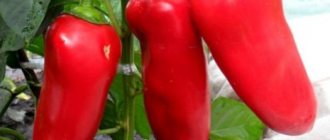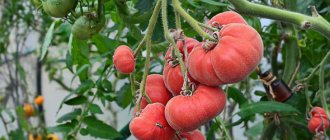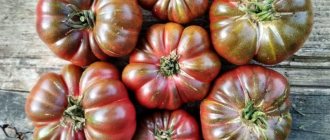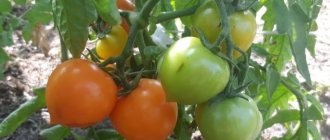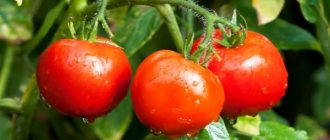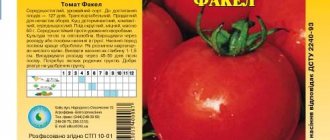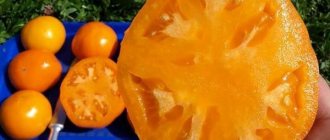Description of the tomato variety Striped pepper
According to the description, tomatoes of the Pepper Striped variety (pictured) have an unusual color and shape. They ripen in the mid-early period, 3.5 months from the moment of seed germination. The tomato was created for regions of risky farming; it is not adapted to open ground conditions. In Siberia and the Urals, cultivation is possible only in a closed way.
In the Central and Middle zones, at the beginning of the season, tomatoes are grown in a greenhouse. After the night temperature has been established at no lower than +150 C, the covering material is removed. Further agricultural technology comes down to growing crops in open ground.
Important! In the southern regions, striped pepper is not popular because the tomato is moisture-loving, during the hot season, voids form in the pulp, and cracks appear on the surface.
Pepper striped - determinate type variety with limited growth
The bush is not standard; it is formed into 1–2 stems. The tomato is compact and quite thick. Constantly forms side shoots that do not stop growing. Without pinching, they reach the length of the central stems.
Pepper striped is a hybrid representative of the culture. In greenhouse conditions it can reach a height of 1.2 m, in open ground - 70–95 cm.
External characteristics of the bush:
- The stems are medium thick, hard, light green, sparsely pubescent. They droop under the weight of the fruit and require a fixing structure.
- The leaves are compound with small segments, light green. The leaf blade is elongated, pointed, the edges are jagged, the surface is corrugated, only the lower part is pubescent.
- The flowers are bright yellow, large, collected in a cluster-shaped inflorescence of 8–10 pieces.
- 5–6 fruit clusters are formed on the bush, the density is the same: 6–9 ovaries.
- The root system is superficial, branched, powerful.
Description of fruits
The main value of a tomato is the exotic color of the fruit. When the tomatoes ripen, the bushes look very decorative. The main background of the fruit is red with longitudinal orange strokes of varying lengths and widths.
Characteristics of tomatoes:
- Tomatoes are shaped like peppers. Their length is 15–17 cm, weight – 80–120 g. On all fruit clusters, the size and weight of tomatoes are the same.
- The peel is smooth, hard and thick, prone to cracking. In the sun, a pearlescent tint is visible.
- The pulp has a high dry matter content. It is bright red and dense. In cross-section, the central segment is white, fibrous, and hard.
- The tomato has 4 deep seed chambers.
- The seeds are small and produced in small quantities. Pepper stripe does not produce seeds from which seedlings can be grown.
Attention! The germination of the material is low, the seedlings do not retain their varietal characteristics.
The taste of the tomato is sweet and sour, balanced, the smell is unexpressed.
Each tomato has a unique pattern: some fruits are dominated by red, others are orange.
Description and characteristics of the striped pepper tomato, reviews, photos
Mid-season, productive , indeterminate, cluster tomato variety. Can be grown both in a greenhouse and in open ground with a garter to a support.
The bush is strong, well-leafed, about 1.4-1.6 meters , not higher than 1 m . It is better to form it into 2-3 stems. During the season, up to 5 clusters of 6-10 tomatoes are tied on the bush.
Basic qualities of fruits
The fruits are pepper-shaped, elongated, dense, at ripeness red with a golden sinuous stripe, very beautiful, fleshy. The weight of one fruit is 100-120 grams . These tomatoes are good for fresh salads and for canning. The skin is dense and does not crack. When preserved, the fruits remain firm, do not become soggy, and do not change color.
Productivity of the variety : up to 16 kg of fruits from 1 plant (subject to agricultural practices).
Planting pattern : 70 x 40 - 50 cm. Planting density: 4 plants per 1 sq.m.
You can see other interesting varieties by looking through our Tomato Catalog with photos, reviews, descriptions. Enjoy watching!
This is a natural variety of tomato. Therefore, we recommend taking seeds from a ripe fruit and using them for planting in subsequent seasons.
Characteristics of tomato Striped pepper
Striped pepper is a crop for greenhouses. Tomato has low stress resistance and reacts sharply to temperature changes. In unfavorable conditions, the growing season slows down and the fruits ripen later. On the site, the bed is placed only in a well-lit place; the brightness of the color of the tomatoes depends on this factor.
Tomato productivity Striped pepper and fruiting
Fruit ripening is uniform, not extended. The harvest takes place in mid-August and lasts 3 weeks. Pepper striped has an average yield; 2 kg are taken from one bush. There are no more than four bushes per 1 m2, and the yield is 7–9 kg.
Tomato fruiting is stable and does not depend on how the crop is grown. In order for the yield to correspond to the indicator declared by the copyright holder, the Striped Pepper is fed and nurtured.
Area of application of fruits
The hybrid has a standard taste profile. It can be consumed fresh, made into juice or included in vegetable salads. Striped pepper is often processed for winter harvesting; the size of the fruit also makes it possible to preserve the tomato as a whole.
Resistance to diseases and pests
During the process of hybridization, strong immunity was established at the genetic level. Pepper stripe is not susceptible to diseases that threaten nightshade crops. In rare cases, late blight may occur. The variety is also resistant to pests. The only problem when growing is whitefly.
Description and characteristics of the variety
The Striped Pepper tomato from “Sedek” has a determinate type of bush, which grows up to a meter in a greenhouse, and does not exceed 70 cm in open ground. The tomatoes are collected in clusters of 5-9 pieces, up to 5 such clusters develop on the stem. They ripen in an average period of 115-120 days after seed germination. The fruiting period extends from July to September.
The fruit is pepper-shaped, red in color with golden-orange or yellow stripes, which can be of varying thickness. The average weight is 80-120 g, length - up to 15 cm. The pulp is dense, fleshy, but at the same time tender, the taste is good. Tomatoes look beautiful when canned, do not lose their shape and color, and are also used for fresh consumption and in cooking.
The fruits of this hybrid variety contain folic acid, carotene, provitamin D, and many vitamins.
Advantages and disadvantages
The first fruit cluster is formed close to the ground, so when ripe the fruits may be spoiled. To avoid this, the bushes must be tied to a support.
Pepper striped is characterized by increased shelf life; the fruits retain nutritional value for up to two months
pros
- exotic coloring;
- amicable maturation;
- good taste;
- versatility in use;
- same weight of tomatoes;
- standard care;
- transportability;
- long shelf life;
- strong immunity.
Minuses
- average yield;
- the presence of white fibers in the pulp;
- hard peel;
- does not provide material for reproduction;
- The variety is recommended only for greenhouses.
Description
Belongs to the family of pepper hybrids, belongs to the mid-late varieties, ripens approximately 115-120 days after germination. The bushes are of a determinate type; in the garden they grow up to 70 centimeters in height; in a greenhouse they can reach one meter. The plants are powerful, medium leafy, the fruits are arranged in clusters. 5-9 tomatoes are formed in one cluster, and 5-6 clusters can ripen in a season. Fruiting is quite long; you can enjoy the fruits from mid-July to September.
Tomatoes are pepper-shaped, up to 15 cm long, and the weight of one tomato is 80-120 grams. When ripe, the fruits turn red, with golden stripes across the entire surface. The skin is dense and not susceptible to cracking. The pulp is fleshy, tender, and tastes sweetish. The variety is perfect for slicing and vegetable salads, suitable for canning; when canned whole, the tomatoes retain their shape.
Interesting! Tomatoes contain many vitamins necessary for the body, carotene, folic acid and provitamin D.
It can be grown throughout Russia except for the northern regions; in the middle zone it is recommended to plant it in a greenhouse. Like many hybrids, “Pepper Striped” is resistant to common diseases; the variety also tolerates short-term drops in temperature and heat. The yield is good, if you follow all care recommendations, you can harvest up to 10 kg of tomatoes from one square meter. Tomatoes store well and can be transported even over long distances.
Advantages
- Excellent taste.
- Attractive looking fruit.
- Universal application.
- The skin of tomatoes does not crack even during heat treatment.
- Excellent immunity.
- Can be stored and transported.
Flaws
- When ripe, the fruits do not stick well to the bushes.
Features of cultivation
Pepper striped is grown by seedlings:
- Sowing of seeds is carried out in early March. Purchased grains do not require processing.
- Prepare containers with a side height of 15–25 cm. The containers are doused with boiling water or a solution of potassium permanganate.
- Mix soil, peat, sand, compost, add superphosphate. Land for sowing seeds can be purchased at the store.
- The containers are filled with substrate. Make furrows 1 cm deep and sow tomatoes.
- The soil surface is moistened and covered with film. After the emergence of shoots, it is removed.
- When the third leaf appears, the seedlings are picked.
The seedlings are watered every other day, and nitrogen is added a week before removal to the greenhouse or hotbed.
Seedlings are planted at two months of age. Approximately from mid-May. Place the tomato in a furrow or a separate hole, the bottom is first covered with a layer of humus. Deepen the seedlings to the top leaves at an angle so that the stem touches the soil. Fall asleep and water. 3–4 plants are placed per 1 m2.
Growing variety:
- Regular removal of weeds and loosening of the soil. To eliminate this procedure, the root circle is mulched.
- Pinching and tying to a support.
- Water so that the soil does not dry out, but there is no stagnation of water.
- Fertilize with organic matter. During flowering, phosphorus is added, when tomatoes begin to ripen - potassium.
- Two weeks before harvest, all fertilizing is stopped.
Growing seedlings
On the territory of the Russian Federation, tomatoes are grown in seedlings. In order for the seedlings to be strong and resilient, a lot of effort must be made. The seed material is carefully selected; first, the seeds are sorted by hand, then soaked in a 5% saline solution; empty, unusable seeds will rise to the surface, good ones will remain at the bottom. After selection, you can disinfect them with a 1% manganese solution for 30 minutes. As a rule, manufacturers do this on their own, but excess processing will not harm, because it kills pathogens of fungal, bacterial and viral infections. If you germinate the seeds before planting, then the sprouts will appear on the surface of the earth much earlier.
Interesting! In order for the seeds to become more hardy, they are moistened in aloe juice.
The soil is also prepared in advance. To make it, turf soil, peat, sand and humus are used. If it was made in the fall, during the winter it is taken out into the cold, then brought into the warmth. Before sowing, such a soil mixture must be spilled with a hot solution of manganese or calcined in the oven. A few days before sowing, the soil must be moistened.
Sowing of seeds is carried out 65 days before planting seedlings in the soil. The soil is poured into boxes or separate containers; the latter option is much more convenient, since the plants will not need to be picked in the future. If the seeds are planted in a common container, grooves are made in the moist soil, the seed is placed in them, and then crushed with earth. At first, water the future seedlings with a spray bottle so that the seeds do not move.
The optimal temperature before emergence is 23-25 degrees, after which it is reduced by several units. To prevent seedlings from stretching out, you need to provide good lighting. The seedlings are placed on the windowsill on the sunny side and, if necessary, illuminated with a lamp. As a rule, 2 weeks after the sprouts appear, the seedlings produce the first leaves; the presence of 2-3 pieces indicates the need for picking.
It is advisable to take 500 ml containers; they will have enough space for the development of the root system. You need to replant young seedlings very carefully, because they are very easy to damage. After approximately 5-6 weeks, the first flower cluster will begin to form on the seedlings, and at this time they can already be transferred to their permanent habitat. If seedlings are grown correctly, they have thick stems, large foliage and powerful roots.
Characteristics of the variety
The pepper-shaped striped variety belongs to the family of pepper-shaped hybrids. It has average fruit ripening limits, which occur on the 115th day after sowing the seeds. The variety is characterized by long fruiting, which begins in mid-July and lasts until the end of September.
Like other pepper varieties, the Striped variety also bears large and very tasty fruits, which is why it is so loved by many gardeners.
Striped tomato plants, unlike other varieties, are more suitable for the definition of “semi-determinate” rather than “indeterminate”. The height of the bushes in a greenhouse does not exceed 120-130 centimeters, and in open ground it does not reach even a meter. The bushes themselves have a lush dark green crown and are overgrown with five to six tassels, which bear 8-10 fruits. To obtain a more abundant harvest, it is recommended to grow plants in a greenhouse with two stems, and in an open garden bed with one. Despite the fact that the bushes do not grow too large and have a powerful stem, the plants still do not hold their weight well even without fruit, so they need to be tied up immediately after planting.
The fruits themselves are similar in appearance to sweet peppers.
Their shape is cylindrical, elongated (up to 15 centimeters), weight 120-160 grams. The peel is dense, smooth, and in the stage of full maturity is colored red with yellow longitudinal sinuous stripes (tiger color). Fact : Because the tomatoes have a thick skin, peppery striped tomatoes are great for canning.
When salted, they do not crack or lose their shape. The pulp is juicy, fleshy, but at the same time dense and tender. Tomatoes look good sliced.
As befits a hybrid, the Striped Pepper variety is reliably protected from various diseases. Plants can survive short-term temperature changes, extreme heat, and lack of moisture without any consequences.
Advantages of the variety:
- good taste of fruits;
- original shape and color of tomatoes;
- long fruiting period;
- Suitable for various uses;
- can be grown both in a greenhouse and in open ground;
- dense skin is not prone to cracking;
- plants do not get sick;
- tomatoes are stored for a long time;
- tolerate transportation well;
- fruits contain a large amount of dry matter;
- Tomato contains vitamins, carotene, provitamin D, folic acid.
Minuses:
- plants do not hold fruit well.
Productivity is reported to be good. With a planting density of 3-4 plants per square meter, you can collect up to 7 kilograms of “tiger” tomatoes. And with strict adherence to agricultural technology, the productivity of tomato bushes can reach 10 kilograms per square.
